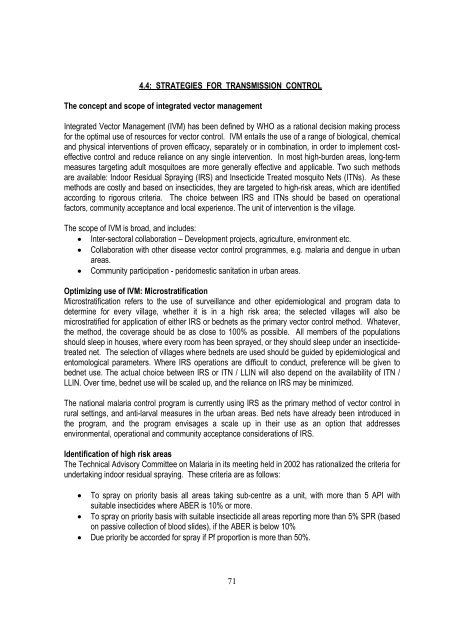training module for medical officers primary health centre - NVBDCP
training module for medical officers primary health centre - NVBDCP
training module for medical officers primary health centre - NVBDCP
- No tags were found...
Create successful ePaper yourself
Turn your PDF publications into a flip-book with our unique Google optimized e-Paper software.
4.4: STRATEGIES FOR TRANSMISSION CONTROLThe concept and scope of integrated vector managementIntegrated Vector Management (IVM) has been defined by WHO as a rational decision making process<strong>for</strong> the optimal use of resources <strong>for</strong> vector control. IVM entails the use of a range of biological, chemicaland physical interventions of proven efficacy, separately or in combination, in order to implement costeffectivecontrol and reduce reliance on any single intervention. In most high-burden areas, long-termmeasures targeting adult mosquitoes are more generally effective and applicable. Two such methodsare available: Indoor Residual Spraying (IRS) and Insecticide Treated mosquito Nets (ITNs). As thesemethods are costly and based on insecticides, they are targeted to high-risk areas, which are identifiedaccording to rigorous criteria. The choice between IRS and ITNs should be based on operationalfactors, community acceptance and local experience. The unit of intervention is the village.The scope of IVM is broad, and includes: Inter-sectoral collaboration – Development projects, agriculture, environment etc. Collaboration with other disease vector control programmes, e.g. malaria and dengue in urbanareas. Community participation - peridomestic sanitation in urban areas.Optimizing use of IVM: MicrostratificationMicrostratification refers to the use of surveillance and other epidemiological and program data todetermine <strong>for</strong> every village, whether it is in a high risk area; the selected villages will also bemicrostratified <strong>for</strong> application of either IRS or bednets as the <strong>primary</strong> vector control method. Whatever,the method, the coverage should be as close to 100% as possible. All members of the populationsshould sleep in houses, where every room has been sprayed, or they should sleep under an insecticidetreatednet. The selection of villages where bednets are used should be guided by epidemiological andentomological parameters. Where IRS operations are difficult to conduct, preference will be given tobednet use. The actual choice between IRS or ITN / LLIN will also depend on the availability of ITN /LLIN. Over time, bednet use will be scaled up, and the reliance on IRS may be minimized.The national malaria control program is currently using IRS as the <strong>primary</strong> method of vector control inrural settings, and anti-larval measures in the urban areas. Bed nets have already been introduced inthe program, and the program envisages a scale up in their use as an option that addressesenvironmental, operational and community acceptance considerations of IRS.Identification of high risk areasThe Technical Advisory Committee on Malaria in its meeting held in 2002 has rationalized the criteria <strong>for</strong>undertaking indoor residual spraying. These criteria are as follows: To spray on priority basis all areas taking sub-<strong>centre</strong> as a unit, with more than 5 API withsuitable insecticides where ABER is 10% or more. To spray on priority basis with suitable insecticide all areas reporting more than 5% SPR (basedon passive collection of blood slides), if the ABER is below 10% Due priority be accorded <strong>for</strong> spray if Pf proportion is more than 50%.71
















